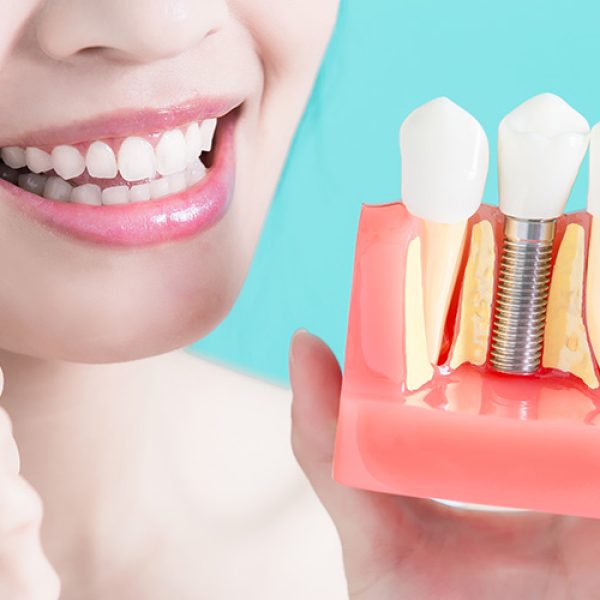The Modern Solution for a Confident Smile
DENTAL IMPLANTS

DENTAL IMPLANTS

If you’ve ever lost a tooth — whether from an accident, gum disease, or just the wear and tear of life — you know it’s about more than a gap in your smile. It can change the way you speak, the foods you enjoy, and how confident you feel in everyday moments.
The good news? Dentistry has come a long way. Dental implants have transformed how we replace missing teeth, offering a solution that looks, feels, and works just like the real thing. Unlike dentures or bridges, implants are designed to last for decades and keep your jawbone healthy in the process.
In this guide, we’ll walk you through everything you need to know:
What dental implants are and how they work
The benefits beyond just appearance
The step-by-step process
Who’s a good candidate
Cost, aftercare, and common questions

At their core, dental implants are small, screw-like posts made from biocompatible materials (most often titanium). They’re surgically placed into the jawbone where your natural tooth root once was. Over time, the bone naturally fuses to the implant in a process called osseointegration, creating a stable foundation for a replacement tooth.
Once the implant is securely integrated, a custom-made crown is attached on top. This crown is designed to match the color, shape, and size of your surrounding teeth so seamlessly that most people will never know it’s not your original tooth.
While a beautiful smile is the most obvious perk, implants do much more than improve your appearance.
Dental implants mimic the structure of natural teeth, right down to the root. They don’t slip, click, or shift — so you can laugh, talk, and eat without worry.
With proper care, dental implants can last decades, often a lifetime. Compare that to dentures, which may need replacing every 5–8 years, or bridges, which can wear out in 10–15 years.
When a tooth is lost, the surrounding bone begins to shrink due to lack of stimulation. Implants act like a natural tooth root, keeping the jawbone strong and maintaining your facial shape.
Forget about adhesives or nightly removals. Once in place, implants stay put, offering a stable bite and comfortable fit.
Unlike traditional bridges, implants don’t require altering nearby healthy teeth for support, meaning more of your natural teeth remain untouched.
Getting dental implants is a multi-stage process that prioritizes healing and long-term stability.
Your dentist will start with a thorough oral exam, X-rays, and possibly a 3D scan. They’ll check your gum health, bone density, and medical history to ensure implants are a safe and effective choice for you.
Under local anesthesia (and sedation if needed), the dentist surgically places the implant into your jawbone. This stage is surprisingly painless for most patients thanks to modern anesthesia techniques.
This healing phase is crucial. Over 3–6 months, the implant fuses with your jawbone, creating the stability that makes implants so reliable.
Once healed, a small connector piece called an abutment is attached to the implant. This will hold your custom crown.
The final step — your permanent crown is secured onto the abutment. It’s shaped and shaded to blend perfectly with your other teeth.
Dental implants work for most healthy adults, but some factors can influence eligibility.
Good candidates usually have:
Healthy gums free from active gum disease
Enough bone density to support an implant
No uncontrolled chronic conditions (like diabetes) that affect healing
A commitment to good oral hygiene and regular dental visits
If your jawbone has already thinned, don’t worry — procedures like bone grafting or sinus lifts can often make implants possible.
Just like natural teeth, implants need regular care to stay healthy.
Daily Care Tips:
Brush twice daily with a soft-bristled toothbrush
Floss or use interdental cleaners to remove plaque between teeth
Avoid chewing on hard items like ice or pens
Wear a nightguard if you grind your teeth
Professional Care:
See your dentist for regular checkups and cleanings
Get professional advice on any signs of gum inflammation or discomfort
The cost of dental implants varies depending on the number of teeth replaced, the complexity of the case, and your location. While the initial investment is higher than dentures or bridges, implants are often more cost-effective over time due to their durability and low maintenance.
Many dental clinics offer:
Payment plans
Financing options
Insurance assistance (partial coverage in some cases)
Modern anesthesia and surgical techniques make implant placement virtually painless. Most patients report mild soreness for a few days afterward.
Implants are for adults of all ages who have lost one or more teeth.
A well-made crown is indistinguishable from natural teeth.

A missing tooth doesn’t have to be the end of your perfect smile. Dental implants provide a strong, natural-looking, and long-lasting solution that restores both function and confidence. They’re not just about replacing a tooth — they’re about giving you back the joy of eating your favorite foods, speaking without hesitation, and smiling without holding back.
If you’ve been considering implants, talk to a qualified dentist. You might be just a few steps away from the confident smile you’ve been missing.